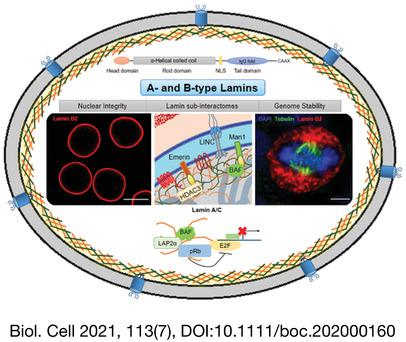当前位置:
X-MOL 学术
›
Biol. Cell
›
论文详情
Our official English website, www.x-mol.net, welcomes your
feedback! (Note: you will need to create a separate account there.)
Role of A- and B-type lamins in nuclear structure–function relationships
Biology of the Cell ( IF 2.4 ) Pub Date : 2021-02-26 , DOI: 10.1111/boc.202000160 Shalaka Patil 1 , Kundan Sengupta 1
Biology of the Cell ( IF 2.4 ) Pub Date : 2021-02-26 , DOI: 10.1111/boc.202000160 Shalaka Patil 1 , Kundan Sengupta 1
Affiliation

|
Nuclear lamins are type V intermediate filament proteins that form a filamentous meshwork beneath the inner nuclear membrane. Additionally, a sub-population of A- and B-type lamins localizes in the nuclear interior. The nuclear lamina protects the nucleus from mechanical stress and mediates nucleo-cytoskeletal coupling. Lamins form a scaffold that partially tethers chromatin at the nuclear envelope. The nuclear lamina also stabilises protein–protein interactions involved in gene regulation and DNA repair. The lamin-based protein sub-complexes are implicated in both nuclear and cytoskeletal organisation, the mechanical stability of the nucleus, genome organisation, transcriptional regulation, genome stability and cellular differentiation. Here, we review recent research on nuclear lamins and unique roles of A- and B-type lamins in modulating various nuclear processes and their impact on cell function.
中文翻译:

A 型和 B 型核纤层蛋白在核结构-功能关系中的作用
核纤层蛋白是 V 型中间丝蛋白,在内核膜下方形成丝状网状结构。此外,A 型和 B 型核纤层蛋白亚群位于核内部。核层保护细胞核免受机械应力并介导核-细胞骨架耦合。层粘连蛋白形成一个支架,部分地将染色质束缚在核膜上。核层还稳定涉及基因调控和 DNA 修复的蛋白质-蛋白质相互作用。基于核纤层蛋白的蛋白质亚复合物涉及细胞核和细胞骨架组织、细胞核的机械稳定性、基因组组织、转录调控、基因组稳定性和细胞分化。这里,
更新日期:2021-02-26
中文翻译:

A 型和 B 型核纤层蛋白在核结构-功能关系中的作用
核纤层蛋白是 V 型中间丝蛋白,在内核膜下方形成丝状网状结构。此外,A 型和 B 型核纤层蛋白亚群位于核内部。核层保护细胞核免受机械应力并介导核-细胞骨架耦合。层粘连蛋白形成一个支架,部分地将染色质束缚在核膜上。核层还稳定涉及基因调控和 DNA 修复的蛋白质-蛋白质相互作用。基于核纤层蛋白的蛋白质亚复合物涉及细胞核和细胞骨架组织、细胞核的机械稳定性、基因组组织、转录调控、基因组稳定性和细胞分化。这里,











































 京公网安备 11010802027423号
京公网安备 11010802027423号